RE: Circuit protection for small health & beauty product (for mass-production) similar to a foot spa whereby a portion of the user's body will come into direct contact with 1.5 gallons of water within the vessel. See original question link here: Do I still need a fuse if I'm using a GFCI?
Main components of vessel:
IP65 silicone heat pad: 500 watts @ 120VAC = 4.17a Note: adhered to stainless steel bottom; does not come into contact with the water. Air pump: 17 watts @ 12VDC = 1.42a LED: 70 pixels @ 0.3w per pixel/5vdc = 4.2a Total: 9.79A + 1 amp (auxiliary parts) = 10.79a total
Main components of PCBA: OLED display, two Pots, power button and AC/DC converters
Safety measures implemented to-date:
Silicone heat pad in lieu of heating element
14/3 or 16/3 (TBD) GFCI cord similar to this one: https://www.amazon.com/dp/B000HEKUJA Note: Power cords with GFCI do not come with overcurrent protection. We will require overcurrent protection for the following reasons: A. we will seek UL, CE and other certifications in the future; B. "The Penny in the Fuse Box" https://www.schererelectric.com/blog/electrical/the-penny-in-the-fuse-box-and-other-diy-electrical-panel-nightmares/ Note: One of our stakeholders owns a large mechanical contractor company. He was the first one to alert me to "The penny in the fuse box" scenario. He says, "it happens more than you would believe. So, YES, you need overcurrent protection!"
Our options as we see them:
- GFCI cord + auto reset thermal circuit breaker like these: https://www.kuo-yuh.com/97-series-auto-reset-circuit-breaker.html https://www.alibaba.com/product-detail/Kuoyuh-97-series-10A-single-pole_1600651596086.html
Notes: This would have been the ideal solution for us had it not been for the potential major negatives as pointed out by these two EE's: see @PStechPaul comments on my previous question Stack Exchange link above. Also, see LEX@REDARC #1331 comment (second from top) here: https://www.redarc.com.au/forum/discussion/255/circuit-breaker-vs-fuse
Question: Is this still a problem with "thermal" auto reset circuit breakers today? One would think they have perfected this technology by now.
GFCI cord + PCB (on-board) fuse: this still may be an option, although we still have reservations about this. Our initial concern was if the fuse blows, they will need to take it for repair. However, our PCB designer said: "if a major fault occurs they will need to take it to the repair shop anyway." Note: (added 6/12/23) a few engineers brought up that in some cases, overloads are temporary for one reason or another and that all it takes is a flip of the circuit breaker to be back up and running again. A PCB fuse cannot be replaced by a layman. Hence, should a temporary overload blow the fuse, the user would be required to take it to the shop for no other reason but to replace the PCB fuse if the problem for the temporary overload could not be determined.
GFCI cord + manual reset circuit breaker (off-board). This seems to be LEX@REDARC preferred option although his comments were made nine years ago before advancements in auto reset fuses occurred, assuming advancements in auto reset fuse technology have occurred and I don't know that they have.
Have someone make a custom GFCI cord with overcurrent protection. Note: if you are interested PM me. We will be needing 5,000 (+/-) per month starting Q3, 2024.
Our conclusions to-date based on what we've learned to-date:
if auto reset fuses no longer exhibit the potential problems as noted by @PStechPaul and LEX@REDARC above, then we would probably choose this option. If the potential problems with auto reset fuses still exist, we will most likely rule this option out; even if there is a work-around because we prefer following the KISS method.
still a possibility, but have reservations
still a possibility, highest probability Note: the question with this option now becomes...do we use a GFCI circuit breaker in a distribution box or use #4 with a push button circuit breaker mounted separately in the product's compartment.
still a possibility, but have reservations
Your comments and suggestions will be very much appreciated.
Thank you in advance,
Notes: That link to the cord is for example purposes only. We won't be buying any parts for this mass production product off of Amazon. We are an OEM and will be dealing in volumes where we will be able to bypass all distributors and only deal with the manufacturers of any parts we utilize. We will be required to get three bids and probably accept the middle bid, which is typical.
We've already considered fuse inlets for the main power cord. The product has another inlet with a conventional shape on the vessel (the vessel and power tower are not integral; the tower plugs into the vessel) so we had to change the main power cord and inlet thereof to an unconventional shape to force the user to use our GFCI cord which will be supplied with the product and also to prevent the user from plugging the main power cord into the inlet on the vessel. Because of the unconventional shape of the main power inlet, we have been unable to find a fuse/inlet combo so we have ruled using a inlet/fuse combo out for the time being.
The GFCI cord can not be attached to the power tower because of packaging related problems and assembly related costs. Also, there are two types of GFCI cords 120vac or 230vac; one for EU/UK and the other for US. Hence, less cost to just change the cord out in lieu of attaching two different cords 120vac or 230vac to the tower. Also, if GFCI goes out, the user just buys an other GFCI power cord from us.


